Jamaica Looks to the Future
As a young nation, Jamaica has experienced a fair measure of inconsistency in its economic and political management. The country faces several major challenges to further development. A stagnating economy, currently beset by a variety of financial crises, must be jump-started. The island's fragile, but economically critical natural resource base must be protected. Prospects for […]
Living in Jamaica Today
Jamaicans are modern people, and their life is not that different from that in the United States. They dress much like Americans, wearing Nikes, T-shirts, and jeans; watch television; listen to music; and go to movies. British influence is evident in sports and education. Today, popular culture, although uniquely Jamaican, is more often developed on […]
Economy
Jamaica is classified as a less developed country (LDC), as is true of countries throughout the Caribbean and elsewhere in Latin America. The nation faces many problems that hinder economic growth. It also has many advantages that, if properly developed, can boost development. IS JAMAICA A WEALTHY COUNTRY? Gross domestic product (GDP) is one of […]

Administration and Government
Jamaica is a democratic country but one beset with many problems. This chapter describes and explains the country's governance, its divisions, and the problems it faces in serving its people. COUNTIES AND PARISHES Jamaica is divided into three counties, each of which is further divided into parishes. In the mid-nineteenth century, Jamaica had a total […]
People and Culture
POPULATION TRENDS Size of population is an important characteristic of any country. It determines the number of houses, schools, and hospitals; the size of the labor force; and the amount of food and water it is likely to need. The total population of Jamaica in July 2003 was an estimated 2.7 million, with an annual […]
History
Jamaica has a remarkable and dramatic history, one of merging peoples and cultures. The island's inhabitants enjoy a culture that is a blend of traditions from various groups that have come to the island over time. They include the native Taino Indians, the English colonizers, and Africans who were introduced to the Caribbean to perform […]
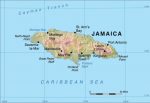
Natural Environment
Jamaica has a rich and varied natural environment. The island's land features range from low-lying coastal plains to the Blue Mountain crests reaching nearly 7,500 feet (2,286 meters) in elevation. Part of the island is a lush tropical paradise, and some areas are dry much of the year making them almost desertlike in appearance and […]

Introducing Jamaica
On a blustery January day, would you like to be on a tropical island? Come to Jamaica, a country of sun-drenched beaches, warm tropical breezes, and a rich cultural heritage. Jamaica is an island nation and a close neighbor of the United States. It is a masterpiece of tropical splendor and extraordinary vistas. The natural […]
Chile Looks Ahead
Pablo Neruda, Chile's national poet, wrote this poem to express his belief in the spiritual strength of the Chilean people. The nighttime is the darkness of Chile's uncertain future. The guitar is the land. The Chilean people are the dawn; they have the power and energy to strum the guitar, awaken the darkness, and reveal […]
Living in Chile Today
URBAN LIVING Nearly all Chileans live in cities. The typical Chilean city has traditional-style, adobe buildings and quaint plazas in the older sections. Modern-style offices and other buildings are scattered along major streets. The tallest buildings hardly reach four or five stories in most cities. The suburbs range from hastily built callampa (mushroom in Chilean speech) […]
Economy
Chile has one the world's best performing economies. A measure of a country's economic performance is the Gross Domestic Product (GDP). The GDP is the value of all goods and services produced by a country. From 1990 to 2000, Chile's GDP grew 5.2 percent annually. This was the highest rate of GDP growth among all […]
Government and Politics
hile has a democratic government that allows every adult the right to vote. Its laws apply to everyone. Its citizens have the right to receive fair trials, and they can meet and discuss freely their political and religious beliefs. As a democratic government, the nation educates its citizens, which enables them to make informed decisions […]
People and Culture
Geography and history formed the crucible from which Chile was born. In the twentieth century, the country survived dictatorships and social upheavals to become a model of democracy in Latin America. Today, the vitality of its people and culture heighten the world's respect for this small nation even more. POPULATION Chile's 15.7 million people are […]
Chile Through Time
Chile's remote location has influenced much of its history. Indigenous peoples of the area lived on the distant fringe of the Inca civilization. Stretching from what is now Ecuador to middle Chile, the Inca Empire preceded the Spanish Empire in the Andes region. The Incas conquered Chile's northern natives and most of the natives occupying […]

Physical Landscapes
Three major landform regions divide Chile: the Andes Mountains, the coast and islands, and the Central Valley. The regions run north to south and parallel to each other. The Andes region is an awesome mountain barrier. Its majestic peaks of spectacular height and bone-chilling temperatures define the country's eastern border. The nation's coast includes imposing […]
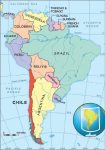
Chile: Introduction
Chile has a little of everything. It is rich in copper, fruits, forests, and fish. It is a country of dramatic scenery and many climates. Cool waters stroke its shore and icy glaciers crown its peaks. Sighs of volcanoes and jolts of earthquakes shake its ribs. Squeezed between the heights of the mountains and the […]
Carl Skottsberg and the Plants of Southern South America
At Punta Arenas, in southern Chile, there is a botanical garden named in honor of one of the world's greatest botanical explorers. The Jardin Botanico “Carl Skottsberg” was founded in 1970, just a few years after the death of the Swedish botanist Carl Skottsberg (1880–1963). Early in his career, Skottsberg took part in a Swedish […]
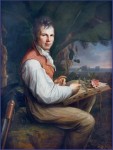
Alexander von Humboldt and the Plants of South America
Alexander von Humboldt's exploration of South America, accompanied by the French botanist Aime Bonpland (1773–1858), did much to establish biogeography as a distinct scientific discipline, but Humboldt was much more than a geographer. In his most famous work, Kosmos, published in five volumes between 1845 and 1862, he wrote that “I always wanted . . […]

Atacama: The Oldest Desert: South America
T he ancient, cold Atacama Desert might as well be on another planet. In fact, when scientists wanted to find a place harsh enough to test the robots they planned to send to Mars to look for the faintest, most beleaguered traces of life, they came first to this 700-mile-long (1,100 km) desert in northern […]
Weather: Chile
This is the world's most linear country: Chile spans 38° of latitude but less than 2° of longitude at its narrowest point. All along that length, the Andes and the Pacific face off. This means the gradual transition from sub-tropic to sub-polar along Chile's length is rivalled by the changes that occur in a short […]
Weather: South America
Bone-dry deserts overlooking tropical oceans, perpetual windswept chill, hushed tropical splendour – South America isn't lacking in climatic variety. As opposed to the chameleon-like seasonal shifts found in Asia and North America, South America specializes in more-uniform climates that maintain their bold, distinctive hues throughout the year. Despite the “South” in its name, a good […]
South America’s stray hurricane
People in Brazil aren't used to hurricanes, to put it mildly. In fact, no hurricane had ever been reported there until 28 March 2004, when a mysterious system packing winds up to 137 km/hr (85 mph) swept onto the coast of Santa Catarina province. Forecasters from Brazil and from the US National Hurricane Centre had […]
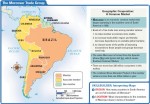
Spanish-Speaking South America
A HUMAN PERSPECTIVE In the early 1500s, the Inca empire was at the height of its glory. Then Spanish soldiers under the command of Francisco Pizarro invaded the South American empire. The Spanish attacked the Inca army, killed many of its warriors, and took the emperor prisoner. The Spaniards held him for ransom. Although the […]

Jamaica
Area 6,829 square mi (10,991 square km) Population 2.721 million 2014 Capital Kingston Highest Point 7,401 ft (2,256 m) Lowest Point 0 m GDP $14.36 billion 2013 Primary Natural Resources bauxite, gypsum, limestone, sugarcane. JAMAICA, SOME 62 mi (100 km) south of CUBA, is the third-largest island in the CARIBBEAN SEA and is full of […]
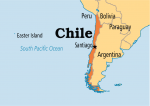
Chile
Area 302,778 square mi (756,950 square km) Population 17.77 million 2014 Capital Santiago Highest Point 22,573 ft (6,880 m) Lowest Point 0 m GDP $258.1 billion 2014 Primary Natural Resources copper, fish, agricultural products. CHILE IS A LONG and narrow country in South America, about 3,999 mi (6,435 km) long and an average of 112 […]